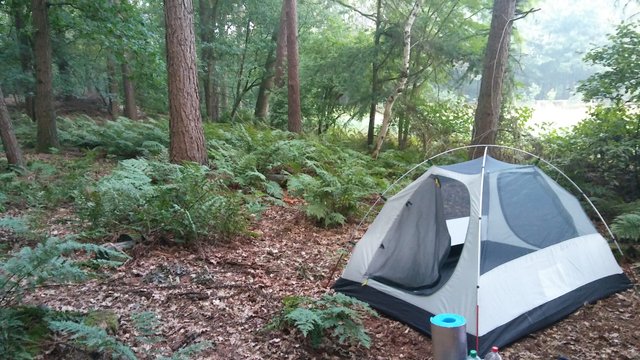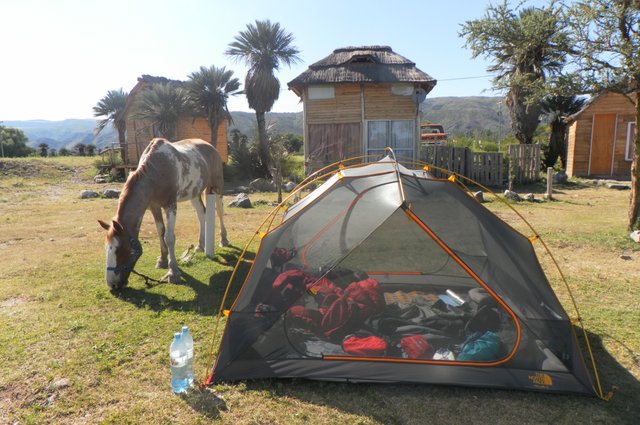INTRO

How to choose the right tent? If we are planning a camping trip for one weekend of the year, this question may seem quite irrelevant, but when we intend to travel quite often, there is a no more important element of preparing for the trip. The tent is our home. Our thermal comfort depends on it, and as a result, health, safety, and comfort depend on it, which in the case of lack of space will result in lack of sleep and fatigue the next day.
Today I will try to present some practical tips that will be especially important for those who intend to go on a backpacking trip and use the tent regularly.
SHAPE
We have several of the most popular tent shapes. The four most common models are the igloo, geodesic tent, tunnel tent, and traditional triangular tent. Each has its advantages and disadvantages, and each is better suited to different situations.
Igloo tents can be set up very quickly with proper practice. If we are forced to do so, we can put it even without the use of pegs, placing the coating without a flysheet on asphalt, rocks, or other hard ground. Of course, this is not recommended, but it's nice to be able to do so in exceptional circumstances.
They cope well with winds and are adapted to winds of changing direction. Since the flysheet in this model does not stick to the tent, the wind causes less noise at night.
Igloo tents take up little space in a backpack and are quite light, but due to their construction, ensuring the right height only in the central part, they have a small usable area. They are perfect for backpackers who have to carry a tent in a backpack, so they want the weight of the item as low as possible.
The construction of geodesic tents is quite similar to those known as "igloos", but with additional reinforcements. The construction limits the amount of space inside, and the additional elements make the tents very heavy and take a long time to set up, but it is the type of tent that is the most resistant to unfavorable weather conditions. For this reason, such tents are rather used during expeditions to less friendly places - high mountains, glaciers, etc.
Tunnel tents are characterized by increased space, often additional vestibules, and height, which allows for comfortable use of almost the entire space. They are set up much longer, and their weight is much greater than the weight of "igloo" tents, so they are the best solution for family camping when the tent and other things are transported by car.
They work well with constant winds blowing in a specific direction.
Tents with a traditional, triangular shape are rather a thing of the past. Very few companies still produce them, because they are very ineffective. Their size and weight are quite high, a large part of the space near the walls is unusable due to their construction, and they do not cope well with any winds.
| Tent | igloo | geodesic | tunnel | triangular |
|---|---|---|---|---|
| For whom? | Backpackers | Extreme escapades | Family camping | for children in the garden |
SIZE AND WEIGHT
When we travel on foot or by bike with a backpack on our backs, the weight and volume of the tent are particularly important to us. If we travel with several people, it is worth dividing the package between all backpackers - one traveler can have a tent in his backpack, the second flysheet, and the third rack so that the total weight is evenly divided between everyone.
Tents with an aluminum frame are much lighter than those made of fiberglass. Aluminum will also be more resistant to unfavorable weather conditions.
When choosing the appropriate tent height, it is considered that the height of the bedroom should allow for sitting in the tent with faces facing each other. In practice, this means 85-90 cm in height.
When choosing the size of the tent, we need to find a balance between its weight and our comfort. For shorter trips, you can compromise on space, but when you're going to live in a tent for a few months, it's better to consider buying it a bit bigger. In my experience, when traveling alone with a large backpack, it is worth choosing a tent 0.5 places larger (such tents often have a "+" tag in the description, for example, 1+, 2 + ...), when traveling with two or three, one place for luggage should be included. If we travel with a dog, it is good to think about the space that the animal takes up
| Number of people | 1 | 2 | 3 | 4 |
|---|---|---|---|---|
| hand luggage | 1-person | 2-person | 3-person | 4-person |
| backpackers | 1,5 person | 3-person | 4-person | 5-person |
| backpackers + dog | 2-person | 3,5-person | 4,5-person | 6-person |
WATERPROOF
One of the most important factors. Good quality tents have two water resistance parameters: one is for the flysheet and the other is for the floor of the tent. Don't even think about buying a single-shell tent without a separate tropic - this is a bad idea.
Although an ordinary umbrella provides us with a water resistance of 600 mm and it is completely sufficient in ordinary rain, it should be remembered that the tent loses its waterproofness over time with long use, so much higher parameters are required. Also, remember that during our travels it happens that we come across real downpours. There is nothing more unpleasant than waking up in the middle of the night, preventing your luggage from getting wet and water from all over the tent, so try to avoid it.
Tents used at weekends or during car journeys, when we can take shelter in a vehicle in heavier rainfall, can have a flysheet with a water resistance of 1500 mm and a floor of 2500 mm. When traveling as a backpacker, it is worth choosing the flysheet with a waterproofness of 4000 mm and a floor of 6000 mm, and the best tents that will pass the test even in the most unpleasant conditions have the waterproofness of the flysheets and floors at the level of 10,000 mm +. It is worth adding that the flysheets covered with impregnation with a UV filter will serve us for a much longer time. We can impregnate them as part of the tent restaurant after prolonged use at home, using special liquid available for purchase in any backpacker store.
Staying on the topic of water, I would like to add a few words about the moisture inside the tent. The risk of moisture and mold growth depends to a large extent on the material the tent is made of. A cotton bedroom provides us with a nice microclimate, but absorbs moisture very intensively, polyester bedrooms are characterized by poor moisture transfer from the interior of the bedroom, while mosquito-net bedrooms are the best. However, if we decide to use tents made of material other than mosquito nets, make sure that they have an appropriate number of ventilation openings. The gable openings at the top of the tent are best.
A good tent should have at least two vents.
| Tent | Average | Good | Perfect |
|---|---|---|---|
| Tropical water resistance | 1 500 mm | 4,000 mm | 10,000 mm |
| Floor water resistance | 2 500 mm | 5 500 mm | 10,000 mm |
| Bedroom material | cotton | polyester | mosquito net |
RESISTANCE TO WEATHER AND OTHER CONDITIONS
I briefly wrote about this when describing the construction of the tent, but there are a few additional things worth mentioning:
- aluminum frames are more resistant than fiberglass frames
- when the tent has three or more racks, it is more resistant than the one with only two (but its weight is greater and the setup time is longer)
- tents with tightening the flysheet to the floor in the corners, with a tightened tape, are much more resistant
- the more lashings and fasteners, the greater the resistance to weather conditions
- tents with additional sleepers placed underneath protect bedrooms from damage have a positive effect on resistance
In addition, things to consider when buying a tent are:
- guarantee. The tent should have at least a few years of warranty. The best models are often offered with a lifetime warranty, which proves their durability and the highest class of products from which they were made.
- spare parts attached to the tent and allowing for a temporary repair during use.
- number of vestibules, which are perfect for storing equipment that we do not necessarily want to have inside the tent, and which cannot get wet. I used it most often for storing shoes.
- number of entries. Two entrances mean more comfort, better ventilation, but a bit more weight.
SUMMARY
In conclusion, let me introduce you to two tents with which I went around the world. I bought them years ago and it was preceded by extensive research. Of course, they are not the best tents on the market, but they are the best ones available in the country where I bought them and within the budget I had. I would love to get to know your tents - if you are traveling, please share a photo of your tent in the comments and add a few words about it. Write if you are satisfied with it. Perhaps these comments will help someone make the right choice.
 photo: private collection
photo: private collection Husky Bret 2 ($ 180)
A small tent which we used with my husband for backpacking via Europe. It worked very well and it was very light but for two of us, our bags and a dog, it was a bit too small. I strongly recommend it for one backpacker, or two with smaller luggage (and no pets)
 photo: private collection
photo: private collection The north face talus 4 ($ 225)
The bigger tent which we bought before the bicycle trip via South America. It's designed for four travelers but it perfectly worked for three of us and our heavy backpacks.
Thank you for reading,
@papi.mati
 Igloo tent
Igloo tent  Geodesic tent
Geodesic tent  Tunnel tent
Tunnel tent  Triangular tent
Triangular tent 
great bro, you explain in great detail
Downvoting a post can decrease pending rewards and make it less visible. Common reasons:
Submit
Thank you, I'm glad you enjoyed my post
Downvoting a post can decrease pending rewards and make it less visible. Common reasons:
Submit
Un excelente post sobre los tipos de carpa y sus diferentes utilidades.
Una gran guía para los excursionistas novatos, seguro aprenderán mucho y podrán tener idea de la clase de carpa que desean comprar.
Un buen viaje depende de un buen descanso y para un buen descanso se necesita una buena carpa.
SLPS
Downvoting a post can decrease pending rewards and make it less visible. Common reasons:
Submit
Thank you very much. I'm glad you enjoyed my post and I totally agree with the last sentence you wrote.
Have a great day!
Downvoting a post can decrease pending rewards and make it less visible. Common reasons:
Submit